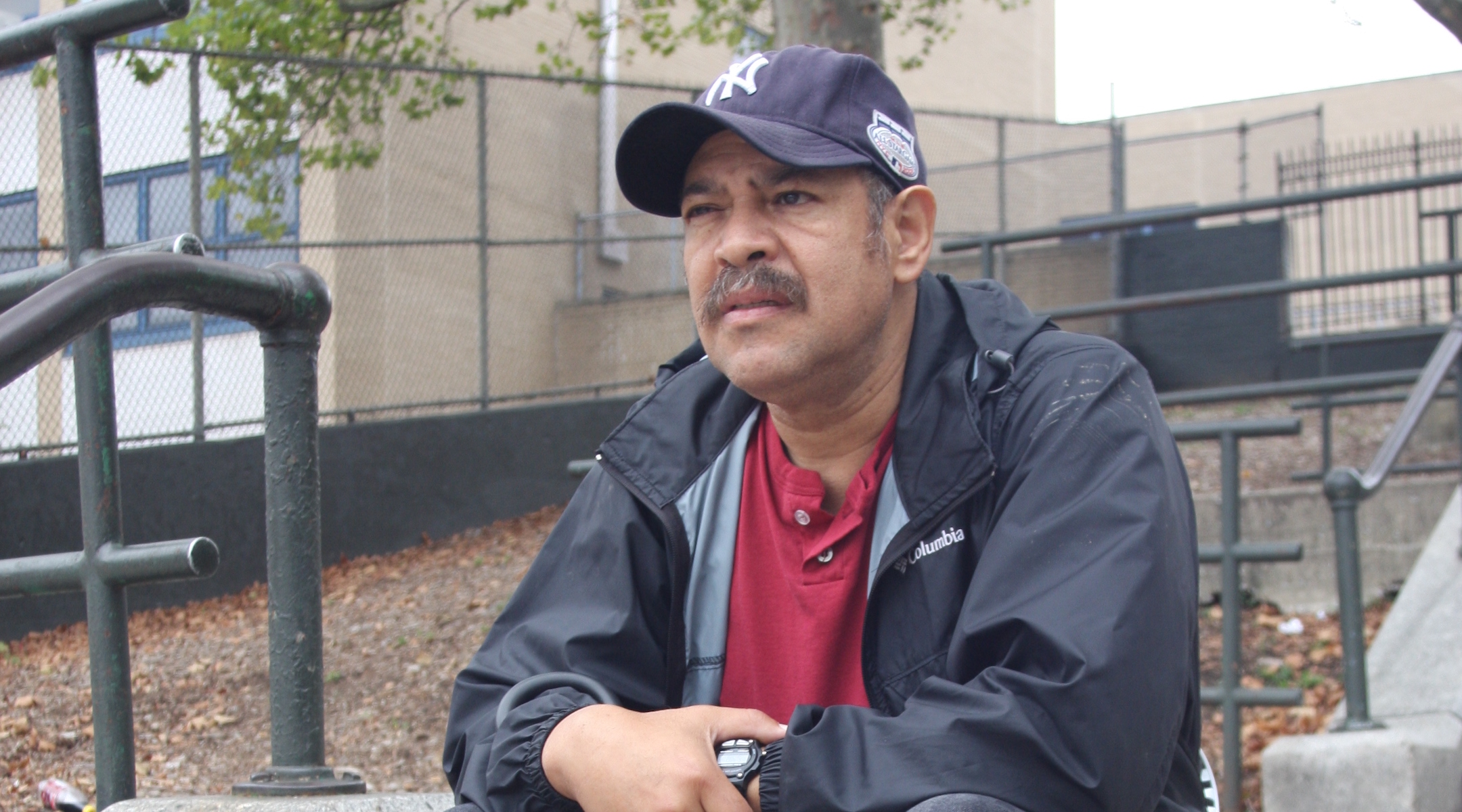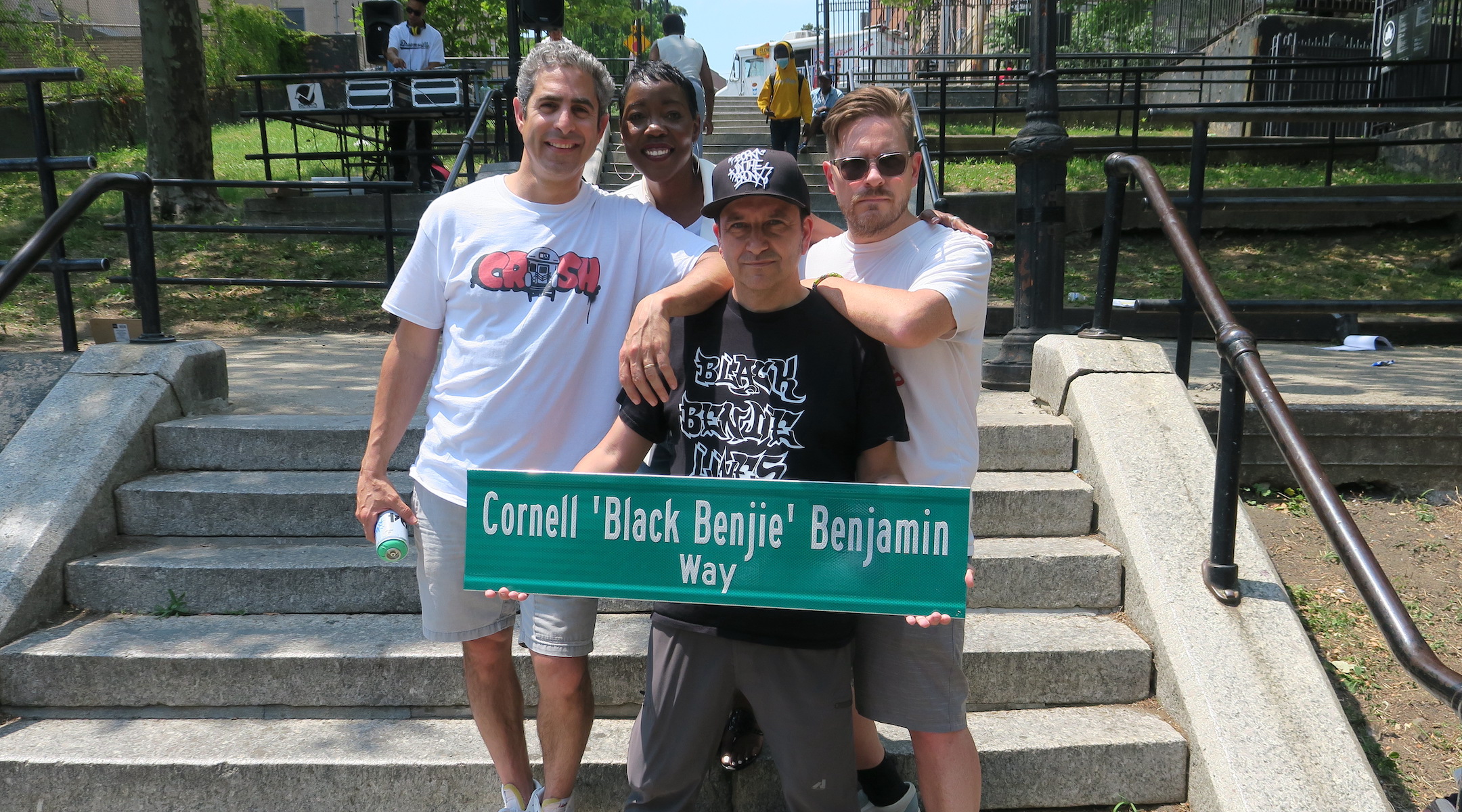‘Can You Dig It?’: New podcast traces how a Puerto Rican-Jewish gang leader helped create hip-hop in the Bronx
Benjamin “Yellow Benjy” Melendez and the Ghetto Brothers brokered a truce among 50 gangs that led to safer streets, a flourishing of public art and, ultimately, the birth of hip-hop

This portrait of Benjamin Melendez was included in the 2010 exhibition “Only in New York.” (Photo by Julian Voloj; Design by Grace Yagel)
(JTA) — In the late 1960s, the Bronx was at war. Rival gangs were fighting over territory in neighborhoods that had been devastated by drugs, poverty and the construction of the Cross Bronx Expressway.
Benjamin “Yellow Benjy” Melendez was the son of Puerto Rican Jewish immigrants and the leader of a multicultural gang called the Ghetto Brothers that promoted peace. After his comrade Cornell “Black Benjie” Benjamin was beaten to death in 1971 while trying to break up a fight, Melendez brokered a truce among 50 gangs that led to safer streets, a flourishing of public art and, ultimately, the birth of hip-hop.
Julian Voloj, an occasional Jewish Telegraphic Agency contributor, published a graphic novel about Melendez in 2015. Now he has co-written and co-produced a five-part podcast about the Ghetto Brothers that debuted on Audible last month in conjunction with the 50th anniversary of hip-hop.
“Can You Dig It?” includes interviews with former gang members and historians, dramatic reenactments of key moments in the Ghetto Brothers’ history and recordings of Melendez, who died in 2017. Chuck D of the legendary rap group Public Enemy narrates the series, and Coke La Rock — who rapped at what is considered to be the first hip-hop party, on Aug. 11, 1973 — spits a few bars and shares some memories.
Melendez’s ancestors were crypto-Jews from Spain who practiced Judaism in secret to avoid persecution during the Inquisition and afterward. Likewise, he kept his faith under wraps during his gang years. While he forbade members of the Ghetto Brothers from wearing swastikas to appear tough, he never explained why the symbol offended him. Later in life, he embraced his Jewish roots and prayed at the Bronx’s Intervale Jewish Center.
RELATED: From Rick Rubin to Doja Cat, Jews have helped shape the first 50 years of hip-hop
Voloj, who lives in Queens, spoke with JTA this week about hip-hop history and how Melendez’s Jewishness has inspired his own projects on the genre.
This interview has been condensed and lightly edited.
JTA: When did you first hear about Benjamin Melendez?
JV: I started a photo series on Jewish diversity in 2005, and I always was looking for interesting characters to photograph. Someone recommended Yellow Benjy. He got his nickname because the mother of his first two kids was Chinese, and there were a lot of other Benjamins in the neighborhood. So I called him up and we met up in the Bronx in 2010 at the stairs where Cornell Benjamin was murdered.
That first meeting was really meant to be just one photograph, but he had this fascinating story and we hit it off. I guess it had to do with my own Latinx, Jewish identity — my parents are Colombian — so we really had a lot in common. When Yellow Benjy died, my kids thought that he was a real relative because they had seen him so many times. He was Uncle Benjy to them.

Benjamin Melendez in 2010. (Julian Voloj)
At its heart, “Can You Dig It?” is a story about gangs of disenfranchised youth fighting over turf. What’s the connection between gangs and hip-hop?
Every culture is part of a certain environment in which it was created. The realities of the 1970s Bronx, there were no youth activities, so the gangs in a way filled this void. Obviously “gang” is a term that’s not one size fits all.
After the Hoe Avenue peace meeting, the Ghetto Brothers invited other gangs into their territory for street parties. There is a direct connection to the early hip-hop parties. The philosophy of early hip-hop was about peace, love, unity and having fun. Only later on did you have gangsta rap with its glorification of violence.
Scholar Joe Schloss says on the podcast that people were always surprised to learn Melendez was Jewish and calls him “a perfect example of what it means to be Jewish in the world in a way that was very different from sort of stereotypical notions of what Jewish is.” Do you agree?
It was one of my main motivations to tell Yellow Benjy’s story in the graphic novel “Ghetto Brother.” He was a proud Puerto Rican Sephardic Jew, and it was a story that was missing from the overall canon on Jewish identity. It was also important that his children have Jewish names, and so his kids have names like Judah, Zipporah, Sarah, Rebecca, Joshua. And with them, his legacy lives on.
Several Jewish personalities are mentioned in the podcast. Can you share a little bit about them?
You have all different aspects of Jewish identity in the story. There’s Benjamin Melendez, who’s a Puerto Rican crypto-Jew. Then you have Robert Moses who comes from a German-Jewish family. The Cross Bronx Expressway is the legacy that he’s most associated with, which really accelerated urban decay and white flight.
Then you have Rita Fecher, whose father was a rabbi. She grew up Orthodox, then divorced her husband and lived as a single mom in the Chelsea Hotel in Manhattan. Fecher was an art teacher at a school in the South Bronx, and she was such a positive influence on all these kids who had never met any Jews. She really cared about them. She allowed them to find their own voice and helped them to think about art. She’s the kind of teacher you wish would exist more.

From left: Pete Chelala, Angelique Lenox, Julian Voloj and Bryan Master at the Cornell Benjamin street renaming ceremony in the Bronx, June 2, 2023. (Courtesy of Voloj)
And she co-produced with Henry Chalafant the 1993 documentary about gang life titled “Flyin’ Cut Sleeves.” How did that come about?
She brought a video camera to the Bronx in the late ’60s, early ’70s, and she gave the kids the camera to document their own lives, which was unheard of. Over a decade later, she tried to track down her former students and see where they ended up. That’s really the powerful thing: you see these angry kids who feel left behind and then you see that everything somehow worked out.
For me, the fascinating part of “Flyin’ Cut Sleeves” is you see Yellow Benjy at the Intervale Jewish Center, the last synagogue of the South Bronx. He goes to services and he’s with Moishe Sacks, who was the rabbi there.
Each episode of “Can You Dig It?” ends with a song by the Ghetto Brothers band, which was fronted by Melendez. Did he rap too?
He really didn’t like hip-hop. It wasn’t his music. He was more of a Beatles fan. He liked Santana.
Although he wasn’t a hip-hop artist, he has a direct connection to the hip-hop troika of [DJ Kool] Herc, Bambaataa, and Grandmaster Flash. Like Herc, he was once a member of the Cofon Cats [gang]. He was friends with Afrika Bambaataa, who may or may not have participated in the Hoe Avenue peace meeting. Grandmaster Flash, who is slightly younger, knew about the Ghetto Brothers growing up and mentions them in his autobiography.
Who is this podcast for?
Anybody who’s interested in nonfiction audio storytelling. Anybody who’s interested in the history of New York. The bookends of every episode are scripted reenactments, like they use in film documentaries. They really allow listeners to dive in and experience the Bronx in the 1970s.
For the hip-hop community, it allows people to discover a different origin story. You can argue over whether hip-hop is really 50 or not because there are so many origin stories. This is one of them.
This article originally appeared on JTA.org.
A message from our Publisher & CEO Rachel Fishman Feddersen

I hope you appreciated this article. Before you go, I’d like to ask you to please support the Forward’s award-winning, nonprofit journalism so that we can be prepared for whatever news 2025 brings.
At a time when other newsrooms are closing or cutting back, the Forward has removed its paywall and invested additional resources to report on the ground from Israel and around the U.S. on the impact of the war, rising antisemitism and polarized discourse.
Readers like you make it all possible. Support our work by becoming a Forward Member and connect with our journalism and your community.
— Rachel Fishman Feddersen, Publisher and CEO


























